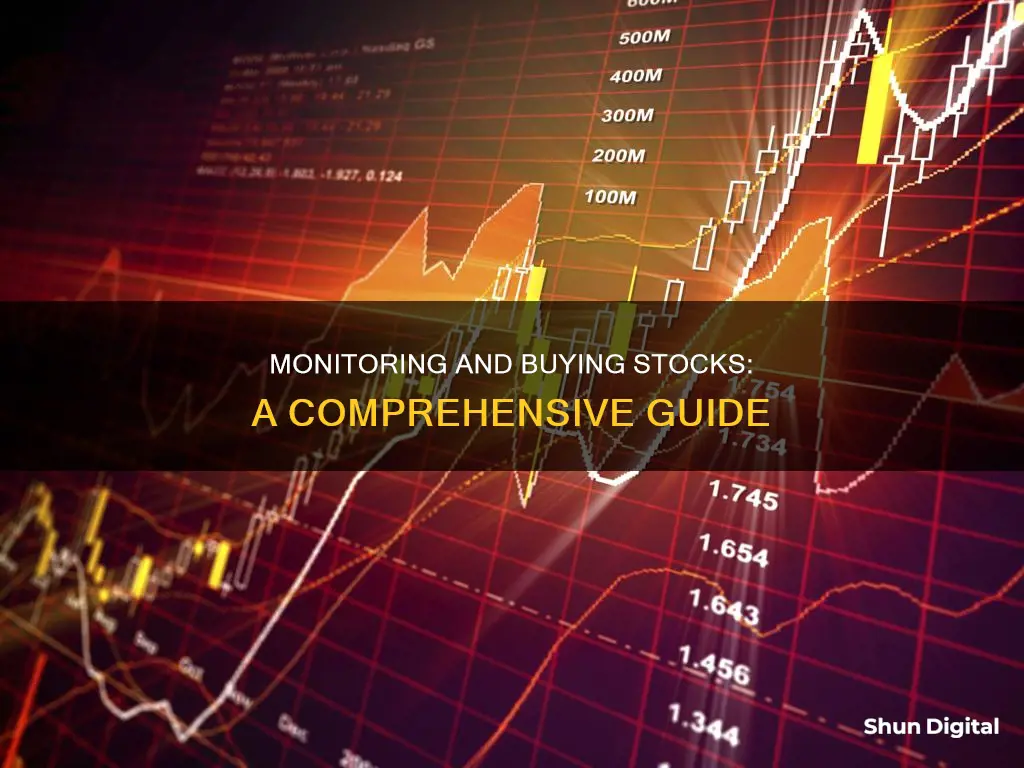
Investing in the stock market can be a great way to set aside money for the future, but it's important to understand the market and the basic principles of investing before you begin. While financial advisors generally advise against day trading and quick buying and selling of stocks, monitoring the stock market can help you buy and sell stocks at the best possible time, optimising your returns. In this article, we'll cover everything you need to know about how to buy and monitor stocks, from finding the right stocks to tracking their performance and making informed buy/sell decisions. We'll also recommend some useful tools and resources to help you get started on your investment journey.
| Characteristics | Values |
|---|---|
| How to find stock information | Search for the ticker symbol in the search field of a financial services website, or use the stock-tracking tools provided by most major internet browsers and search engines. |
| How to interpret stock information | The high, low and closing prices indicate how the stock performed in the previous trading day. Net change (or "change") represents the gain or loss for the stock on a given day. |
| How to set up a portfolio | Most financial services sites and search engines offer a free portfolio tool. All you need to do to establish an online stock portfolio is log in, click on the portfolio or finance section and enter the ticker symbols of the stocks you are tracking. |
| How to set up news alerts | Your online portfolio or brokerage account may offer price or event alerts for your stocks. You can set these services up to send you an email or text when the stock price drops below a certain point or when important company information is reported in the news. |
| How to understand dividends | The dividend column indicates how much the company may pay you to hold a share of its stock for one year. Dividends are paid when the company's net earnings are paid out to all stockholders evenly. |
| How to understand the PE ratio | The PE ratio is the closing price of the stock divided by the earnings per outstanding share. It represents investor confidence that the price of the stock will increase in the future. |
| How to look at trading volume | Volume is the number of shares traded each day. Unusual trading volume may indicate that a stock is either on the rise or anticipating a slump. |
| How to watch for buy or sell ratings | Analysts that follow stocks publish price targets and ratings ("buy", "sell" or "hold"), indicating what they believe savvy investors should do with a given stock. |
| How to identify trends | Look for uptrends and downtrends in the price of a stock over daily and weekly periods. Another way to identify trends is to study the market and the global financial system, looking for relevant news that could affect the stability of an industry or economy. |
| How to find appropriate stock prices | It's easy to find up-to-the-minute stock pricing and breaking market-related news on stock apps and websites. |
| How to calculate future value | A limit order is when you buy or sell stock for a given price that you set. For example, you might wish to buy 10 shares of a stock at $500 per share or less. |
What You'll Learn

Finding Stock Information
Before buying stocks, it's important to do your research and gather as much information as possible about the company you're interested in. Here are some steps to help you find stock information and make more informed investment decisions:
- Understand the company's business and revenue generation: Start by reading up on the company's website and investor-specific information. Look at their business activity, news, and updates. Understand what the company does, its business model, and how it generates revenue. This will help you decide if the stock aligns with your investment goals.
- Review financial reports and key metrics: Analyse the company's financial reports, including balance sheets, income statements, and cash flow statements. Pay attention to revenue, net income, earnings per share (EPS), price-to-earnings (P/E) ratio, return on equity (ROE), and debt-to-equity ratio. These metrics provide insights into the company's financial health, profitability, and efficiency.
- Utilise price charts and watchlists: Price charts can help you spot medium to long-term trends in the company's share price history. They can confirm or contradict your hunches about the direction of the share price. Additionally, creating a watchlist of companies you're interested in can help you monitor their performance and keep important details top of mind.
- Look beyond the numbers: Consider the industry and landscape in which the company operates. Evaluate its competitive advantage, the ease of entry for competitors, potential economic impacts, and the substitutability of its products or services. These factors can influence the company's performance and prospects.
- Evaluate the management team: The management team plays a crucial role in the company's success. Assess their experience, decision-making track record, and communication skills. You can attend earnings calls and shareholder meetings or review recordings to understand how they steer the company and handle challenges.
- Research industry and macroeconomic factors: Study the industry the company operates in, including its strengths, weaknesses, competitiveness, and barriers to entry. Also, consider macroeconomic factors such as inflation rates, interest rates, and economic growth, as they can impact the company's performance.
- Compare with peers: Analyse how the stock has performed compared to its peers in similar industries. Look at return analysis over specific timeframes, competitive advantages, upcoming projects, and price-to-earnings (PE) ratios. This will help you assess the stock's relative value and growth potential.
- Stay informed with news and alerts: Keep track of the latest company news and developments as they can significantly impact stock prices. Positive news may boost stock prices, while negative news may cause a decline. Setting up alerts can help you stay informed and make more timely investment decisions.
- Analyse shareholdings: Monitor the shareholdings of promoters, institutional investors, mutual funds, and other stakeholders. Changes in their holdings can indicate their outlook on the company. For example, decreasing promoter holdings may be a red flag, while high buying activity from institutional investors may signal their positive outlook.
- Consider fundamental and technical analysis: Fundamental analysis focuses on evaluating the company's fundamentals, such as business segments, financials, management, and past performance. On the other hand, technical analysis zooms in on trends in stock prices, assuming that supply and demand dynamics and historical price movements predict future performance.
Performance Monitor: Adding Percent Usage Counters Easily
You may want to see also

Understanding Stock Information
Stock information can be overwhelming at first, but once you understand the components, they provide a valuable snapshot of a company. Here are the basics of understanding stock information:
Stock Quotes and Stock Charts
Stock quotes provide a wealth of information about a company's stock performance and are essential for making informed investment decisions. They include key data points such as the security of interest, its ticker symbol, the price buyers or sellers are willing to pay or accept, and the quantity of shares to be traded. Stock charts visually represent changes in share price and trading volume over time, cutting through rumours and headlines to provide an objective picture of the market and individual stocks. Learning to interpret stock charts is crucial for understanding the best time to buy or sell stocks.
Understanding Key Data Points
Several key data points are communicated to the exchanges to determine the agreed-upon price of a stock. These include:
- Bid and Ask Prices: The highest price buyers are willing to pay and the lowest price sellers are willing to accept for the security.
- Last Trade: The price at which the last trade was executed, often compared to the previous session's closing price.
- Opening Price: The first trade price recorded during the trading day, usually compared to the previous session's closing price to quantify the stock's movement.
- Day's High and Low: Common data points used by traders as a measure of volatility.
Market Capitalization (Market Cap)
Market capitalization, or market cap, refers to the total dollar value of a company's outstanding shares. It is calculated by multiplying the number of outstanding shares by the current market price of one share and provides insight into the company's relative size.
Dividends and Dividend Yield
Dividends are distributions of company earnings to shareholders, representing the amount paid out per share. Dividend yield is calculated by dividing the annual dividend amount by the current stock price and is expressed as a percentage.
Earnings per Share (EPS)
EPS measures a company's earnings per share over the last 12 months and is calculated by dividing the company's most recent annual income by the number of outstanding shares.
Price-to-Earnings Ratio (P/E)
The P/E ratio is a valuation ratio that compares a company's current share price to its earnings per share. It is used to determine the relative value of a company's stock and is particularly useful for comparing companies within the same industry.
Beta
Beta measures a stock's volatility or sensitivity to the overall market. A beta of one indicates the stock moves with the market, while a beta greater than one suggests higher volatility.
Volume
Volume refers to the number of shares traded in a given day. Average volume shows the average daily volume over a specific period, such as 30 days.
Ex-Dividend Date
The ex-dividend date is the cut-off date by which an investor must own the stock to be entitled to the next dividend payment.
One-Year Target Estimate
This value is an estimate of the stock price in one year, based on an average of several analyst estimates. However, it should not be solely relied upon as forecasts may be inaccurate.
ISPs Monitoring: How to Detect and Prevent Snooping
You may want to see also

Working with Brokerages or Advisors
When working with a brokerage, you will want to set up an automatic alert system, such as email alerts, to notify you of any pricing changes in the stocks you own or plan to purchase. This is a necessary time-saving tool, as monitoring stock prices constantly is impractical.
It is also important to read any quarterly reports issued for the stocks or funds you have invested in. These reports contain important information such as the company's leadership, board of directors, significant updates, and stock price history.
If your brokerage offers financial advisors, you can choose to outsource the task of monitoring your stocks to them. Advisors will often give you the opportunity to provide a risk profile and outline your preferences, such as the types of stocks you are comfortable investing in. Depending on the type of account you set up, you can authorise advisors to buy and sell stocks on your behalf.
If you are unsure about the basics of investing, it is recommended that you seek the help of a financial services professional to advise you. While you do not need to pay someone else to manage your investments, educating yourself by reading stock market news and guidance, or seeking help from a professional before investing, is a good idea.
Fixing the ViewSonic VA 1930WM LCD Monitor: A Step-by-Step Guide
You may want to see also

Finding Appropriate Stock Prices
Finding the right stock prices is a crucial step towards safe investing. Here are some strategies and factors to consider when looking for appropriate stock prices:
- Up-to-date Information: It is essential to stay informed about the latest stock prices and market-related news. Utilise stock apps and websites to access real-time data and breaking news.
- Research and Analysis: Before investing, conduct thorough research on the stock. Read recent articles, prospectuses, and information directly from the company. Evaluate the company's future prospects, growth potential, and financial track record.
- Comfort Level and Risk Tolerance: Determine the values and prices you are comfortable with for each stock. Consider how many shares you are willing to purchase at a certain price, knowing that there is a possibility of loss.
- Limit Orders: Consider using limit orders to automate the stock-buying process. With a limit order, you set a specific price for buying or selling a stock, and the order is executed when the stock reaches that price.
- Ticker Symbol: Identify the ticker symbol for the stock you want to track. This is usually a combination of up to five letters, often abbreviating the company's name or product. You can use this symbol to search for stock information on news websites and financial services websites.
- Online Brokerage Account: If you have an online brokerage account, utilise the stock tracking tools provided. These tools will help you monitor current prices and recent trades in your portfolio.
- Price Targets and Analyst Reports: Analyst reports and consensus price targets can provide valuable insights. Compare the price targets of analysts with your own research to make a more informed decision.
- Valuation Techniques: Use valuation techniques such as discounted cash flow (DCF) analysis to estimate the theoretical price target of a stock. If the current stock price is below this value, it may be a good buy.
- Company's Future Prospects: Consider the company's future prospects for growth and profits. This information can help you assess whether a stock is undervalued or overvalued.
- Price-to-Earnings (P/E) Ratio: Evaluate the P/E ratio, which represents investor confidence in the stock's future price increase. A low P/E ratio may indicate an undervalued company, while a high P/E ratio suggests investor confidence in the company's growth.
- Dividends: Examine the company's dividend history and consistency. Companies that consistently pay dividends and increase them over time are generally considered more reliable investments.
- Trading Volume: Pay attention to unusual trading volume, as it may indicate investor confidence or anticipation of a slump. Increased trading volume accompanied by a rise in price reflects positive sentiment, while a decrease in price suggests the opposite.
Remember, investing in the stock market requires a good understanding of the market and investing principles. While these strategies provide guidance, it is essential to do your own research and consult with financial professionals before making any investment decisions.
Monitoring Employee Internet Usage: What Employers Can and Can't Do
You may want to see also

Interpreting Price Changes
- Supply and Demand: The most fundamental factor influencing stock prices is supply and demand in the market. If demand for a stock is higher than the supply, the price will increase, and vice versa. This is influenced by investors' sentiments, attitudes, and expectations about a company's worth.
- Company Performance: A company's financial health and performance are critical factors in interpreting price changes. Positive events, such as strong earnings reports, new product launches, or efficient management, can lead to an increase in stock price. Conversely, negative events like scandals, poor earnings, or management issues can cause a decrease in stock price.
- Economic and Industry Factors: Changes in the broader economy and specific industries can impact stock prices. For example, economic growth can contribute to earnings growth for companies, while industry shifts or government regulations can affect a company's operations and future prospects.
- Market Sentiment and Psychology: The psychology of market participants plays a significant role in stock price movements. Positive or negative news, breakthroughs, or scandals associated with a company can impact investors' sentiments and drive buying or selling behaviour.
- Technical Factors: These include a stock's price history, chart patterns, momentum, and behavioural factors of traders and investors. Technical analysis tools like the P/E ratio or the rate-of-change indicator (ROC) can help interpret price changes and make informed trading decisions.
- Volatility: Volatility refers to the rate of change in a stock's price over time. Highly volatile stocks experience rapid price fluctuations, providing investors with opportunities for profits but also carrying higher risks.
- Global Landscape: Keep an eye on the broader global landscape, including political events, wars, environmental changes, and interest rates. These factors can impact the economic climate and, consequently, stock prices.
While interpreting price changes can be challenging, understanding the interplay between these factors can help investors make more informed decisions when buying and monitoring stocks.
Audio Monitoring: What Should Employers Disclose to Employees?
You may want to see also
Frequently asked questions
You can buy stocks through an online brokerage account. You can also use a premium online brokerage service with lots of stock-tracking features.
You can monitor stocks by using Internet sites that provide daily stock quotes. You can also use stock-tracking tools provided by most major Internet browsers and search engines, such as Google and Yahoo.
You can set up news alerts for stocks through your online portfolio or brokerage account. You can also use a stock monitoring platform such as Stock Monitor to configure alerts.
The high, low, and closing prices indicate how a stock performed in the previous trading day. The net change (or "change") represents the gain or loss for the stock on a given day.







